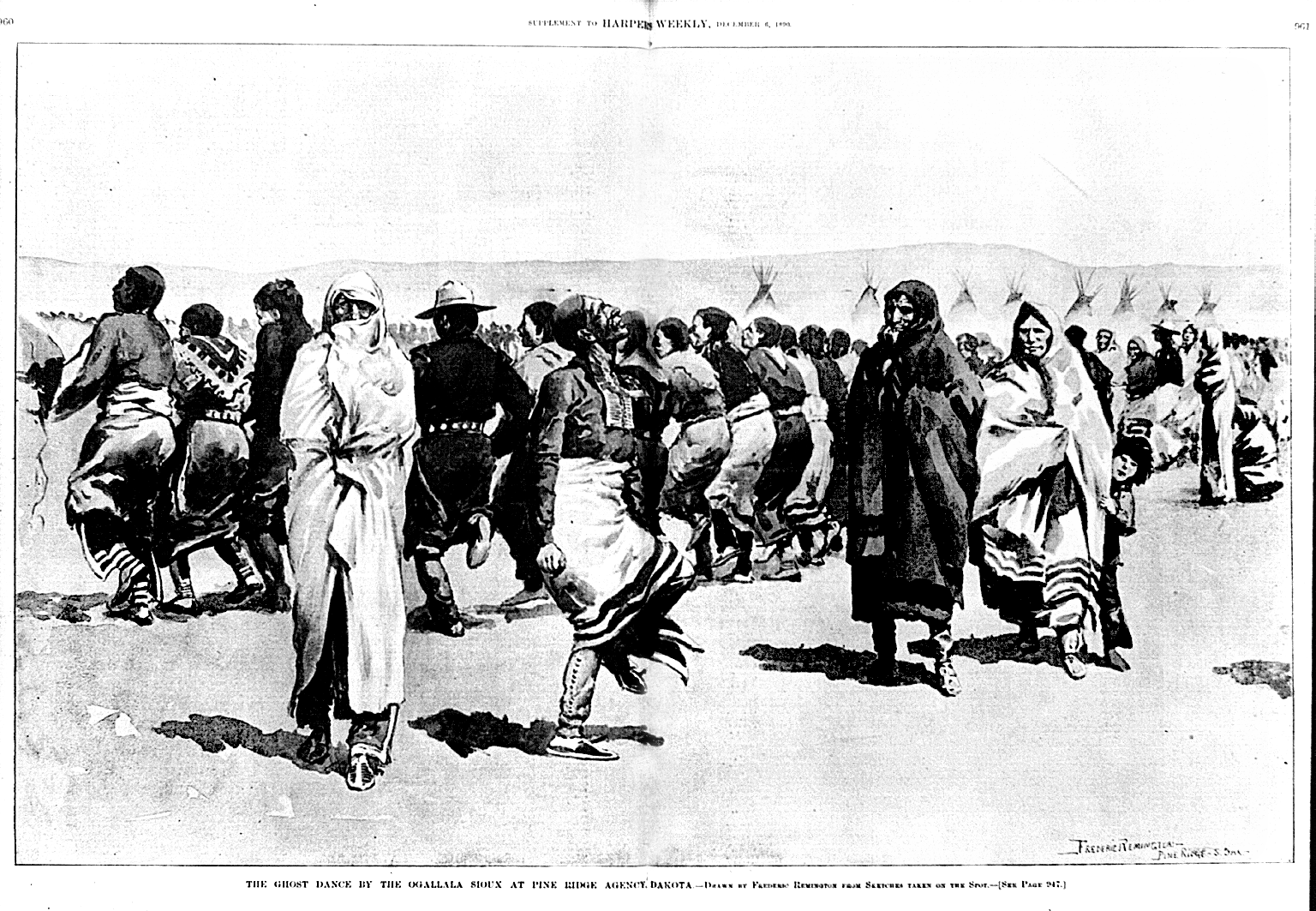Ghost DanceNoted in historical accounts as the Ghost Dance of 1890, the Ghost Dance was a religious movement incorporated into numerous Native American belief systems. The traditional ritual used in the Ghost Dance, the circle dance, has been used by many Native Americans since pre-historic times, but was first performed in accordance with Jack Wilson's teachings among the Nevada Paiute in 1889. The practice swept throughout much of the American West, quickly reaching areas of California and Oklahoma. As the Ghost Dance spread from its original source, Native American tribes synthesized selective aspects of the ritual with their own beliefs, often creating change in both the society that integrated it and the ritual itself.
At the core of the movement was the prophet of peace Jack Wilson, known as Wovoka among the Paiute, who prophesied a peaceful end to white American expansion while preaching messages of clean living, an honest life, and cross-cultural cooperation. Perhaps the best known facet of the Ghost Dance movement is the role it reportedly played in instigating the Wounded Knee massacre in 1890, which resulted in the deaths of at least 153 Lakota Sioux. The Sioux variation on the Ghost Dance tended towards millenarianism, an innovation which distinguished the Sioux interpretation from Jack Wilson's original teachings.Comment: As far as I know, the dances themselves were always peaceful. The only thing "violent" about them was the message some people inferred from a few Lakota dancers. The white man's retribution, which culminated in Wounded Knee, was totally out of proportion to the so-called threat.
This posting is relevant because critics sometimes use the fear of Ghost Dancers to excuse the white man's
genocidal acts against Indians. In general, and not surprisingly, these fears were unjustified. If there hadn't been Ghost Dances, Americans would've found another reason to round up and imprison the Indians in their way.



7 comments:
Writerfella here --
Wovoka's instructions were that the white man should not be told of the exact meaning of the Ghost Dance. And so it was not so communicated. The 'Indian Wars' supposedly were over, and so any such new activity was 'hostile.' The exact language was that the Ghost Dance was to bring back the buffalo, bring back all who had died, and that the world the white man had created would end. Thid still is possible...
All Best
Russ Bates
'writerfella'
See Ghost Dances Promised Death? for more on the subject.
Writerfella here --
Sorry about that "Thid,..." but writerfella is not a touch-typer and in fact taught himself to type at 125 wds. per minute or better. His actual hand-eye coordination somewhere is near zero and so he must look at the keys and not the page when typing. So, "This still is possible..." was the intent and not the execution.
All Best
Russ Bates
'writerfella'
Writerfella here --
writerfella's story, "Fifth And Last Horseman," deals with the modern results of The Ghost Dance, which reveals that all the rest of mankind is doomed for extinction, save for the Native Americans. Why? Because the Natives begin to save the animals with whom they once lived. No one on earth is doing that, right here in River City, but them. It will appear later this year in RED SKIN Magazine, and writerfella is happy...
All Best
Russ Bates
'writerfella'
Recently more and more people are questioning if there were strong Pre Columbian links between Native American people and Tibetan Buddhists. Some have gone so far as to wonder if the Anasazi people were connected either directly or indirectly with Vajrayana Tibetan Buddhism. The reasons for these questions are numerous but are mentioned here
because of the Ghost Dance topic of this site. The Ghost Dance may be a link between Tibet and North America because it has been celebrated in Tibet as a Buddhist ceremony
for centuries. The Ghost Dance was resurrected in North America as the result of a call to the return of all tribal people to the faith of their forefathers. What emerged was a reawakening to ancient religious practices around a central feature--The Ghost Dance. For more information on this topic google: "Mandalas Mantras Manjis and Monuments" or
"Were the Anasazi People Buddhists." Would America be prepared for evidence of significant foreign influences in Pre Columbian America.
Do you know of any connections between the Native American Ghost Dance of 1888 to
1890 to the centuries old Ghost Dance of Tibetan Buddhism? I believe there are
numerous other cultural and religious customs and symbols that provide evidence that these people were
somehow connected in America's Pre Columbian past.
Was The Ghost Dance celebrated on two separate
continents by these separate cultures somehow connected? Google: "Were the Anasazi People Buddhists?" and "Mandalas Mantras Manjis and Monuments".
There appears to be a possible connection between the
NA Ghost Dance and the Tibetan Ghost Dance celebrated for centuries as a Buddhist experience. Some
America scholars of the tribes of the American Southwest
suggest as I believe that there remain numerous connections between tribal cultures and beliefs with Tibetan Buddhism. Google: "Dimensions of Dine (Navajo) and Buddhist Traditions" by Professor Jeannie
Martinez Wells-Univ. of New Mexico Gallop. Peter Gold
has written numerous books on this topic. The Dalai Lama himself believes that there is a connection as do
countless members of the Hopi tribe who have embraced
his spiritual leadership. For more info on this topic
google: "Were The Anasazi People Buddhist? --"Mandalas, Mantras, Manjis and Monuments" and "Hendon's Geoglyphs". We have so much more to learn
about this exciting topic.
Post a Comment